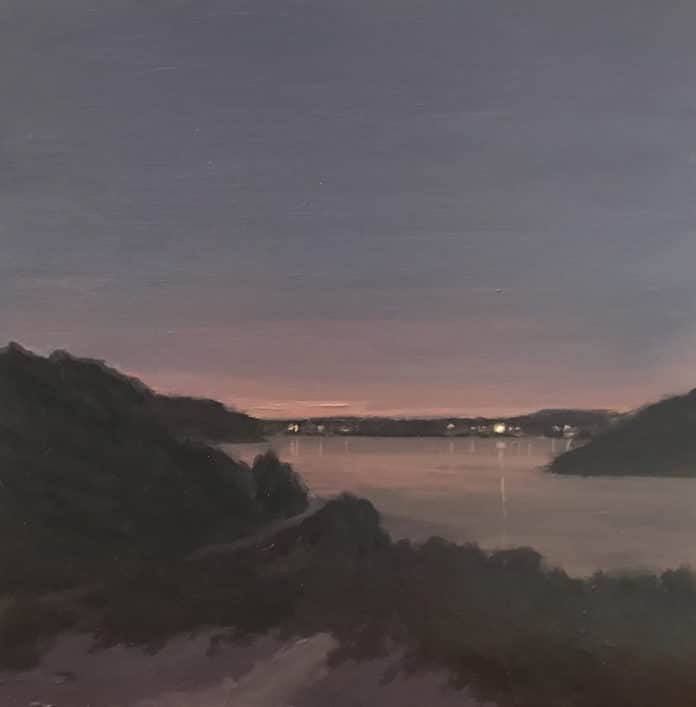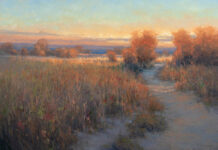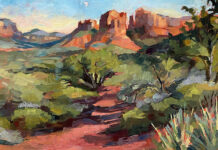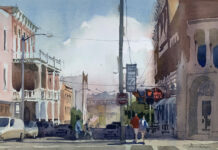San Francisco
12 x 12 in., acrylic on canvas
Studio 2018
Available through Edgewood Orchard Gallery
Brian Sindler was born in Chicago in 1957. He received a bachelor of arts from Columbia College in Columbia, Missouri. Working as a musician for years, he did not take up art until he was into his thirties.
His earliest work was rather abstract. This was long before he took up landscape painting. His subjects were primarily figurative, although he also painted still life subjects. This work generally involves highly simplified forms consisting of broad planes of subdued colors, often arranged in an almost cubist style.
These paintings tend to be thickly painted. Sometimes Sindler created multiple layers with several applications of paint and oil plus a torching of the paint surface. The result is interesting from both a compositional as well as textural point of view.
After about two years of exploring this experimental approach to painting, Brian Sindler took up etching. His subjects remained the same—figurative and still life. But now he delved more directly into cubism and other modernist tendencies. His work from this period was greatly influenced by Picasso.
Sindler began classes at the American Academy of Art in Chicago in 1996. From 1997 through 2001, he was enrolled at the School of Representational Art, a French-style atelier in Chicago.
The work from this period resembles the rigorously detailed work of talented students from the various art academies that were popular in the nineteenth century. There is much attention given to the careful depiction of models and still life arrangements. Accurate drawing, modeling of the form in two-dimensional space, and chiaroscuro effects are all emphasized.
Some of Sindler’s work from these years has a photorealist quality, particularly the charcoal drawings. His considerable talents are very much in evidence.
After graduation, Sindler turns his attention to landscape painting, especially plein air painting. That would remain his focus from then on. Much of the work from this period is impressionist in style and is clearly influenced by Monet and other French impressionist painters. The focus is on lighting and color effects. The impasto is thickly applied and broken brushstrokes are often in evidence.
Sindler readily adopted this style. After some practice, his paint handling became masterful and confident. His paintings from this period tend to be boldly colorful and exuberant. Many of these landscape paintings were executed in and around his home in the North Shore of Chicago.
The artist’s next period is that of a more tonalist style. He has been working in this style since around 2004-2005, although his tonalist work comes in two forms.
His studio paintings tend to be characterized by the use of more subdued colors, the flattening of the pictorial space, and a thinner paint application with broad bands of color. The work which is done en plein air tends to have more vivid colors and a thicker impasto.
But, of course, there are many exceptions to this rule. Sindler may occasionally produce a plein air painting which is so austere that it comes close to being monochromatic. And he may execute a studio painting that is wildly colorful and expressive.
As Emerson suggested, “A foolish consistency is the hobgoblin of little minds.” Sindler’s creative impulse is not at all limited by the need to be consistent. He relishes the opportunities for artistic experimentation and personal growth as an artist.
Sindler is also not constrained by any desire to capture nature as it appears to him at any moment in ever changing lighting and atmospheric conditions. He takes liberties with both forms and colors.
He likes to reduce the number of elements in his paintings and to simplify the forms. So a cluster of four trees, for example, may be reduced to a single form. A complex cloud formation may be turned into a large rising cloud or a pair of floating clouds. Some of this work can therefore appear highly abstract.
Beginning around 2008, Sindler makes more of an effort to impose an even greater control over the design of his paintings. He further simplifies the forms in his compositions and he reduces the number of forms.
Sindler also adopts a two-step process to aid him in the design of his plein air paintings. The first step is to create quick sketches from nature that provide a kind of design template for the painting. Then later he returns to the same location to paint the scene en plein air by taking account of both the natural setting before him and the planned design sketch which guides him in the composition of the painting.
With this approach, Sindler’s arrangement of forms and choice of the coloration of these forms allow him to achieve a more balanced composition and a more compelling contrast between light and dark tones.
His tonalist style has had a very contemporary sensibility about it. But since around 2012, he has produced some paintings that come closer to the American Tonalism style of the late nineteenth and early twentieth century. This work is somewhat more painterly and less abstract, although the forms are still highly simplified. In these paintings, formal considerations take a back seat to contrasting tonalities and color harmonies. The effect is both poetic and sublime.
Brian Sindler has exhibited widely in individual and group shows. In additional to gallery exhibitions, he has been a regular exhibitor at the Salmagundi Club in New York, the Plein Air Festival in Door County, Wisconsin, and the Cedarburg Plein Air Competition. He has been awarded numerous prizes in these competitions.
From time to time Sindler conducts painting workshops at the North Shore Art League in Winnetka, Illinois, and at the School of Representational Art in Chicago.
His work is included in a number of private and public collections in the United States and abroad.
~Michael Greany
View more of Brian’s work at www.briansindler.com.




